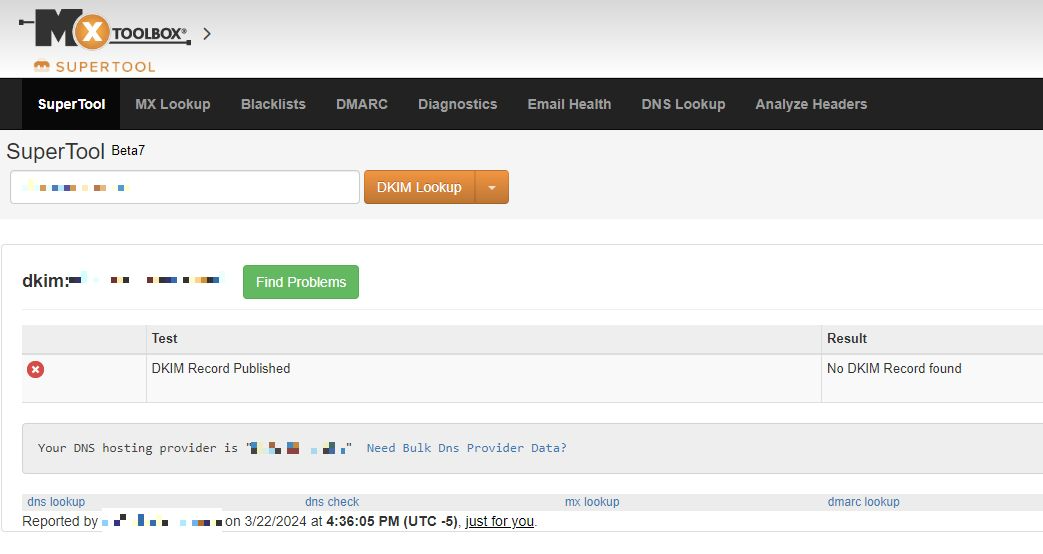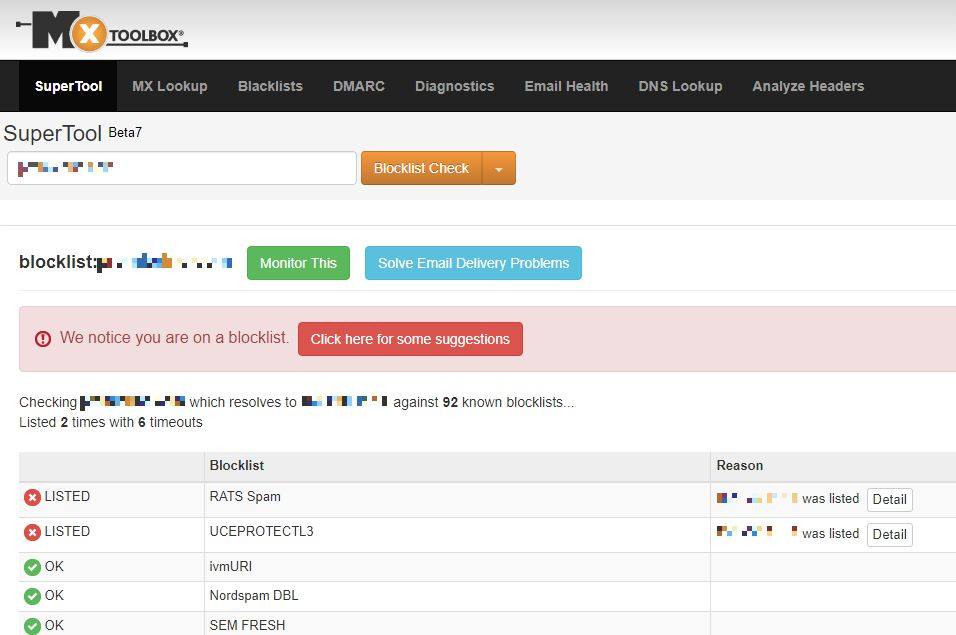Email marketing is a core function of most businesses’ marketing strategy – but it only works if you can get your emails into your prospects’ inboxes. Are you struggling with email deliverability? Maybe you just have questions on what you need to pay attention to? You’re in the right place. Let’s go through the most common causes of email deliverability issues and how to fix them.
Failing SPF/DKIM
SPF defines which internet protocol (IP) addresses can send email for a particular domain, and DKIM verifies an email wasn’t forged or altered. If your email marketing platform is not set up for your domain, it won’t be able to authenticate SPF and DKIM.
Monitor: Check the admin settings in the marketing automation platform or use a third-party tool like Mx Toolbox to verify SPF/DKIM are set up.

Solution: Make sure this is verified via your marketing automation or email marketing platform. After confirming SPF/DKIM setup has been completed and there’s still an issue when sending, contact your IT support to escalate the issue.
Failing DMARC
Domain-based Message Authentication, Reporting & Conformance (DMARC) uses SPF and DKIM in combination and tells the recipient ISP what to do with messages that can’t be authenticated (none, quarantine, or reject). As of Feb 2024, Google and Yahoo now require DMARC for sending domains with >5k recipients.
Monitor: Use a third-party tool like Mx Toolbox to verify DMARC is set-up.
Solution: If DMARC hasn’t been set up, escalate to your IT team.
Sender Reputation is low (sender score)
Sender reputation is based on the engagement of users with your email; a higher amount of records opening and clicking while fewer marking as spam/unsubscribed will increase your sender reputation.
Whether you have a shared versus dedicated IP in your email marketing platform or marketing automation platform plays a role here too. With a shared IP, reputation is impacted by how positive or negative your neighbor’s reputation is; if it’s positive, you will benefit. If it is negative, you will suffer from their behavior.
Monitor: Email bounce data week over week to identify any potential changes in sender score.
Solution: Consider A/B Testing subject lines to increase open rate and increase personalization to make the content more relevant and encourage engagement. Reduce email audience to only those that regularly engage, and slowly increase to a larger audience over time. If this still doesn’t improve your reputation, or it does improve but then tanks again, it is recommended to review where your audience is sourced from or temporarily suspend records that regularly bounce. You might be blocklisted by specific companies, or sending emails to records who are no longer at their company.
Listed as “blocked” on known blocklisting sites
A blocklist is a list of IPs or domains that are sending unsolicited email and engaging in email bad practices. A blocklist can be public or private. In most cases, a company emails a spamtrap email address, and this causes the sender IP to be added to a blocklist.
Monitor: Use a third-party tool like Mx ToolBox. Simply enter in the sending domain, and this will tell you whether it has been blocklisted by any known block lists.

Solution: Reduce your email audience to only those that regularly engage, and slowly increase to a larger audience over time; do not send to records who have recently hard bounced (this may require your marketing operations team to implement a bounce management framework in your marketing automation platform). If this doesn’t improve your blocklisting status on things like Mxtoolbox, contact your CSM for the platform. They typically will have a relationship with these blocklisting companies, and if you can vouch for your efforts, they may be able to convince the companies to remove you.
Bouncing from specific companies/ISPs as a known spam/blocklisted
Oftentimes, companies or ISPs will have set parameters for what they consider spam which may automatically trigger you to be listed as spam for their company specifically (outside of sender reputation).
Monitor: Hard bounces by Category 1 bounce in your marketing automation platform – this indicates that the email bounced because it was labeled as spam by the recipient’s mail server.

Solution: Provide your IP/Domain information to the sales rep in charge of the account/prospect. They will need to ask the IT team of this company to whitelist your account. For personal email domains, the ISPs often have sender support request forms or contacts, such as those for Yahoo and Gmail.
Certain campaigns are causing higher unsubscribes/bounces
The email marketing campaign may have faults in the email content or code itself, but it also may be targeting the wrong audience. An unusually large audience size for a particular campaign can trigger ISPs to flag a sender.
Monitor: Bounce rate and unsubscribe rate by specific campaign/program. Comparison between typical and recent daily send volume across email marketing campaigns.
Solution: Check email design, spam words, broken links, or the audience list to determine the cause of the increase. Increase personalization and A/B testing efforts to optimize for recipient engagement. If it happens across more than one campaign, you may have a sender reputation or blocklist concern.
Certain sources are causing higher bounces
It is a bad practice to purchase lists. Oftentimes these purchased lists are old information and are not updated. This leads to higher bounces or invalid emails which affects your sender reputation, deliverability, and opens you up to hitting a honey pot/spam trap (an email address no longer in use that is sold to blocklisting companies for the express purpose of penalizing companies that don’t practice good data hygiene).
Monitor: Email Invalid by Person Source – sort reports or lists by person/original source to identify any trends in bad data sources. Category 2 bounces will indicate an email is invalid or does not exist.
Solution: Review where the information came from and determine if they should be temporarily suspended from email marketing. If it’s an individual, discuss where they’re getting the data from. If it’s a purchased list, consider removing this from your email automation platform database and potentially using the bad records as a reason for refunding.
Increase in User-Reported Spam Rate
Email recipients have the option to mark a received message as spam. This is separate from their ISP simply filtering it to the junk folder. When users report an email as spam, this signals to the ISP that the sender has poor practices and will impact their reputation. Gmail and Yahoo list a threshold of 0.3% spam rate before they may begin redirecting bulk senders to the junk folder or not delivering at all.
Monitor: Spam Rate in Google Postmaster Tools – this metric is Gmail-user-reported spam. Complaints filed with the marketing automation platform through their feedback loops with other ISPs may appear in the marketing automation platform’s unsubscribe log.
Solution: Ensure you’re making the email content as relevant as possible through targeting, personalization and alignment with expectations. Confirm interest periodically. Don’t hide the unsubscribe link in the email or make the process complicated. Establish a practice of removing unengaged contacts from regular email marketing sends.
Image file sizes are too large
Large image file sizes can prevent the email from loading, or potentially cause issues to email deliverability.
Monitor: Soft bounces in the marketing automation platform can indicate the email size is too large and/or timed out.
Solution: Compress using an image compression service such as tinyPNG.
More resources
Email deliverability is crucial and definitely isn’t something you should ignore. Here are some additional resources you may find useful:
- 5 Tips to Getting Started with Email Deliverability
- Google & Yahoo’s Upcoming Inbox Changes – What Does it Mean?
- Improve Your Email Bounce Management in Marketo Engage
- How to Optimize Email Deliverability (Marketo)
- HubSpot Email Health Tool
- Account Engagement (Pardot) Email Deliverability Best Practices







